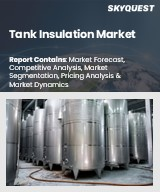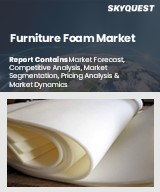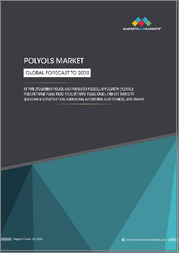
|
시장보고서
상품코드
1622948
세계의 폴리우레탄 폼 시장 : 시장 규모 - 지역별, 범위 및 예측Global Polyurethane Foam Market Size By Type (Rigid Foam, Flexible Foam), By Application (Building and Construction, Automotive), By End User (Building and Construction, Bedding and Furniture), By Geographic Scope And Forecast |
||||||
폴리우레탄 폼 시장 규모 및 예측
폴리우레탄 폼 시장 규모는 2024년에 756억 6,000만 달러로 평가되었고, 2024년부터 2031년까지 7.7%의 연평균 복합 성장률(CAGR)을 나타낼 전망이며, 2031년에는 1 376억 7,000만 달러에 이를 것으로 예측됩니다. 폴리우레탄 폼은 폴리올과 디이소시아네이트의 중합으로 다양한 밀도를 가진 연질 또는 경질 폼을 얻을 수 있는 만능 재료입니다. 단열성, 탄력성, 내구성 등의 독특한 특성으로 다양한 용도에 적합합니다. 일반적인 용도로는 가구 쿠션, 매트리스, 자동차 내장, 건물 단열 패널 등이 있습니다. 또, 항공 우주, 포장, 의료 기기등의 산업에 있어서의 특정의 요건을 만족하도록 설계하는 것도 가능해, 다양한 분야에의 적응성을 나타내고 있습니다.
폴리우레탄 폼은 재료 과학의 진보와 지속가능한 제품에 대한 수요가 증가함에 따라 유망시되고 있습니다. 연구는 재생 가능한 자원에서 유래한 바이오 기반 폴리올에 중점을 두고 있으며, 이를 통해 기존의 석유 기반 폼이 환경에 미치는 영향을 줄일 수 있습니다.
제조 공정의 혁신은 내화성과 재활용성 향상 등 폴리우레탄 폼의 성능 특성 향상을 목표로 하고 있습니다. 산업계가 친환경 솔루션과 에너지 효율을 점점 우선시하게 되는 가운데 폴리우레탄폼은 녹색건축재료와 자동차 경량화 등의 분야에서 매우 중요한 역할을 수행해 보다 지속가능한 미래에 기여할 것으로 기대되고 있습니다.
세계의 폴리우레탄 폼 시장 역학
세계 폴리우레탄 폼 시장을 형성하는 주요 시장 역학
주요 시장 성장 촉진요인
건설 산업의 성장 :
성장하는 건설 업계 : 특히 신흥 국가의 건설 업계의 활황은 폴리 우레탄 폼 시장의 주요 촉진요인입니다. 폴리우레탄 폼은 건물의 단열재, 지붕재, 실링 용도로 널리 사용되고 있습니다. 미국 인구조사국에 따르면 2023년 미국에서 실시된 건설액은 1조 8,000억 달러에 달했으며, 이전보다 꾸준히 증가하고 있어 폴리우레탄 폼과 같은 건설자재 수요가 높아지고 있음을 보여줍니다.
자동차 산업 수요 증가 :
자동차 업계에서는 연비와 쾌적성을 향상시키기 위해 경량 소재가 중시되고 있어 시트, 헤드레스트, 차음재 등의 차재용 폴리우레탄 폼 수요를 견인하고 있습니다. 국제자동차공업회(OICA)의 보고에 의하면, 세계의 자동차 생산 대수는 2022년에 8,500만대에 이르렀으며, 팬데믹에 의한 침체로부터 회복해, 폴리우레탄 폼을 포함한 자동차 부품 시장의 성장을 나타내고 있습니다.
에너지 효율에 대한 의식 증가 :
에너지 절약 건물을 중시하는 경향이 강해, 건축 기준법이 엄격화됨으로써, 주택과 상업 건축 모두에서 폴리우레탄 폼 단열재 수요가 높아지고 있습니다. 미국 에너지부는 미국 에너지 소비의 약 40%를 건물이 차지하고 있다고 추정하고 있습니다. 또, 발포 폴리우레탄을 포함한 적절한 단열재는, 주택에 있어 냉난방 코스트를 평균 15% 삭감할 수 있다고 보고하고 있어, 이러한 재료의 채용을 뒷받침하고 있습니다.
주요 과제
원료 가격 변동 :
폴리우레탄 폼 시장은 석유화학 유도품에 크게 의존하고 있으며, 그 가격은 지정학적 긴장, 자연재해, 공급망의 혼란에 의해 크게 변동될 가능성이 있습니다. 예를 들어 최근 세계 에너지 위기로 원유 및 천연가스 비용이 상승해 이소시아네이트 폴리올의 가격이 상승했습니다. 이러한 변동은 제조업체에 불확실성을 초래하고 가격 설정 및 예산 계획을 어렵게 합니다. 이러한 예측 불가능성은 종종 이익률의 저하를 초래하고 최종 소비자의 비용 상승으로 이어져 결국 시장의 성장을 방해하게 됩니다.
환경에 대한 우려 :
폴리우레탄 폼의 생산과 폐기는 환경에 큰 우려를 가져옵니다. 기존의 폴리우레탄 폼에는 오염이나 건강에 악영향을 미치는 위험한 화학물질이 포함되어 있습니다. 많은 폼은 생분해성이 없고 매립 폐기물의 원인이 되고 있습니다. 플라스틱 폐기물의 삭감을 목적으로 한 사회적 의식의 고조와 엄격한 규제에 의해, 메이커는 환경 친화적인 대체품의 채용을 추진하고 있습니다. 이 이행에는 다액의 연구개발 투자가 필요한 경우가 많으며, 이것이 재원을 압박하고 생산공정을 지연시켜 최종적으로 시장역학에 영향을 줄 가능성이 있습니다.
규제 문제 :
폴리우레탄 폼 산업은 특정 화학물질의 사용과 배출에 대한 엄격한 규제에 직면하고 있습니다. 세계 각국 정부는 프레온(CFCs)과 같은 유해물질을 단계적으로 폐지하고 유럽연합의 REACH 규제를 준수하기 위한 정책을 시행하고 있습니다. 이러한 복잡한 규제에 대응하는 것은 제조사에 있어서 비용과 시간이 소요되어 제품의 출시를 늦출 가능성이 있습니다. 컴플라이언스 위반은 다액의 벌금이나 소문 피해로 이어질 가능성이 있어 기업에 있어서 기술혁신이나 성장에서 초점을 돌릴 가능성이 있는 진화하는 규제에 대해 항상 최신 정보를 입수하는 것은 매우 중요합니다.
주요 동향 :
지속가능성과 친환경 제품 :
지속가능성이 중시되고, 폴리우레탄 폼 시장은 환경친화적인 대체품으로 향하고 있습니다. 소비자와 기업은 재생 가능한 자원으로 만들어진 제품을 요구하게 되어 있고, 제조사는 바이오 기반 폴리올과 저VOC 폼의 개발을 촉구하고 있습니다. 이 동향은, 규제의 강화나 환경 의식의 고조에 의해서 유지되고 있습니다. 지속 가능한 대처에 투자하는 기업은, 브랜드의 평판을 높일 뿐만 아니라, 급성장하는 시장 부문을 개척할 수도 있습니다. 환경의식이 높은 소비자가 친환경 선택을 우선시하는 가운데, 이 시프트는 기세를 올리고 이노베이션을 촉진하며 지속 가능한 폴리우레탄 폼 제품의 수요를 확대할 것으로 예상됩니다.
기술 혁신 :
기술의 진보는 폴리우레탄 폼 시장에 큰 영향을 주고 있습니다. 발포제나 첨가제 개량 등의 제조 공정에서의 혁신은 폼의 특성을 향상시키고 다양한 용도의 성능 향상으로 이어집니다. 새로운 제조 기술은 보다 효율적이고 비용 효율적인 제조를 가능하게 합니다. 각 기업은 가볍고 내구성이 있으며 에너지 효율이 높은 폼을 창출하기 위한 연구 개발에 투자하고 있습니다.
자동차 용도에서 수요 증가 :
자동차 산업에서는 그 경량성과 단열성에 의해 폴리우레탄 폼 수요가 높아지고 있습니다. 제조사는 차량 경량화, 연비 향상, 승객의 쾌적성 향상을 목적으로 좌석, 단열재, 내장 부품에 폴리우레탄 폼을 사용하고 있습니다. 전기 자동차가 보급되면서 경량 소재의 필요성은 더욱 높아지고 있습니다. 이 동향은, 엄격한 배기가스 규제를 준수한다고 하는 메이커의 목표나, 에너지 효율이 높은 자동차를 요구하는 소비자의 기호에 의해서 추진되고 있습니다.
목차
제1장 세계의 폴리우레탄 폼 시장 : 서문
- 시장 개요
- 조사 범위
- 전제조건
제2장 주요 요약
제3장 검증된 시장 조사의 조사 방법
- 데이터 마이닝
- 밸리데이션
- 1차 자료
- 데이터 소스 일람
제4장 세계의 폴리우레탄 폼 시장 전망
- 개요
- 시장 역학
- 성장 촉진요인
- 억제요인
- 기회
- Porter's Five Forces 모델
- 밸류체인 분석
제5장 세계의 폴리우레탄 폼 시장 : 밀도 조성별
- 개요
- 저밀도 폴리우레탄 폼
- 중밀도 폴리우레탄 폼
- 고밀도 폴리우레탄 폼
제6장 세계의 폴리우레탄 폼 시장 : 유형별
- 개요
- 연질 폼
- 경질 폼
- 스프레이 폼
제7장 세계의 폴리우레탄 폼 시장 : 최종 사용자별
- 개요
- 침구 및 가구
- 건축 및 건설
- 일렉트로닉스
- 자동차
- 포장
- 기타
제8장 세계의 폴리우레탄 폼 시장 : 지역별
- 개요
- 북미
- 미국
- 캐나다
- 멕시코
- 유럽
- 독일
- 영국
- 프랑스
- 기타 유럽
- 아시아태평양
- 중국
- 일본
- 인도
- 기타 아시아태평양
- 세계 기타 지역
- 라틴아메리카
- 중동 및 아프리카
제9장 세계의 폴리우레탄 폼 시장 : 경쟁 구도
- 개요
- 기업 시장 랭킹
- 벤더 상황
- 주요 발전 전략
제10장 기업 프로파일
- BASF
- Sekisui Chemical Co. Ltd.
- Huntsman Corporation
- Chemtura Corporation
- Compagnie De Saint-Gobain SA
- Eurofoam Group
- Covestro AG
- Dowdupont
- Nitto Denko Corporation
- Armacell
제11장 주요 발전
- 제품의 출시 및 개발
- 합병 및 인수
- 사업 확대
- 파트너십 및 제휴
제12장 부록
- 관련 조사
Polyurethane Foam Market Size And Forecast
Polyurethane Foam Market size was valued at USD 75.66 Billion in 2024 and is projected to reach USD 137.67 Billion by 2031 , growing at a CAGR of 7.7% from 2024 to 2031. Polyurethane foam is a versatile material created by the polymerization of polyols and diisocyanates, resulting in a flexible or rigid foam with varying densities. Its unique properties, such as excellent insulation, resilience, and durability, make it suitable for a wide range of applications. Common uses include furniture cushioning, mattresses, automotive interiors, and insulation panels in buildings. The foam can also be engineered to meet specific requirements in industries such as aerospace, packaging, and medical devices, demonstrating its adaptability across various sectors.
Polyurethane foam is promising, driven by advances in materials science and growing demand for sustainable products. Research is focusing on bio-based polyols derived from renewable resources, which can reduce the environmental impact of traditional petroleum-based foams.
Innovations in manufacturing processes aim to enhance the performance characteristics of polyurethane foam, such as improved fire resistance and recyclability. As industries increasingly prioritize eco-friendly solutions and energy efficiency, polyurethane foam is expected to play a pivotal role in areas like green building materials and automotive lightweighting, contributing to a more sustainable future.
Global Polyurethane Foam Market Dynamics
The key market dynamics that are shaping the global polyurethane foam market include:
Key Market Drivers:
Growing Construction Industry:
The booming construction sector, particularly in emerging economies, is a major driver for the polyurethane foam market. Polyurethane foam is widely used in building insulation, roofing, and sealing applications. According to the U.S. Census Bureau, the value of construction put in place in the United States reached $1.8 trillion in 2023, showing a steady increase from previous years and indicating a growing demand for construction materials like polyurethane foam.
Increasing Demand in the Automotive Industry:
The automotive sector's focus on lightweight materials for improved fuel efficiency and comfort is driving the demand for polyurethane foam in-vehicle components such as seats, headrests, and sound insulation. The International Organization of Motor Vehicle Manufacturers (OICA) reported that global vehicle production reached 85 million units in 2022, rebounding from the pandemic-induced slump and indicating a growing market for automotive components including polyurethane foam.
Rising Awareness of Energy Efficiency:
Increasing emphasis on energy-efficient buildings and stricter building codes are boosting the demand for polyurethane foam insulation in both residential and commercial construction. The U.S. Department of Energy estimates that buildings account for about 40% of all U.S. energy consumption. They also report that proper insulation, including polyurethane foam, can reduce heating and cooling costs by an average of 15% in residential buildings, driving the adoption of these materials.
Key Challenges:
Raw Material Price Volatility:
The polyurethane foam market is heavily dependent on petrochemical derivatives, whose prices can fluctuate significantly due to geopolitical tensions, natural disasters, and supply chain disruptions. For instance, the recent global energy crisis has driven up the costs of crude oil and natural gas, leading to increased prices for isocyanates and polyols. This volatility creates uncertainty for manufacturers, making it difficult to set prices and plan budgets. Such unpredictability often results in reduced profit margins and can lead to higher costs for end consumers, ultimately hampering market growth.
Environmental Concerns:
The production and disposal of polyurethane foam raise significant environmental concerns. Traditional polyurethane foams contain hazardous chemicals that can lead to pollution and adverse health effects. Many foams are non-biodegradable, contributing to landfill waste. Growing public awareness and stringent regulations aimed at reducing plastic waste are pushing manufacturers to adopt eco-friendly alternatives. This transition often involves substantial research and development investments, which can strain financial resources and slow down production processes, ultimately impacting market dynamics.
Regulatory Challenges:
The polyurethane foam industry faces stringent regulations regarding the use of specific chemicals and emissions. Governments worldwide are implementing policies to phase out harmful substances like chlorofluorocarbons (CFCs) and to comply with the European Union's REACH regulations. Navigating these complex regulations can be costly and time-consuming for manufacturers, potentially delaying product launches. Non-compliance can result in hefty fines and reputational damage, making it crucial for companies to stay updated on evolving regulations, which can divert focus from innovation and growth.
Key Trends:
Sustainability and Eco-Friendly Products:
The growing emphasis on sustainability is driving the polyurethane foam market toward eco-friendly alternatives. Consumers and businesses are increasingly seeking products made from renewable resources, prompting manufacturers to develop bio-based polyols and low-VOC foams. This trend is supported by stricter regulations and heightened environmental awareness. Companies that invest in sustainable practices not only enhance their brand reputation but also tap into a burgeoning market segment. As eco-conscious consumers prioritize environmentally responsible choices, this shift is expected to gain momentum, fostering innovation and expanding the demand for sustainable polyurethane foam products.
Technological Innovations:
Advancements in technology are significantly influencing the polyurethane foam market. Innovations in manufacturing processes, such as improved blowing agents and additives, enhance foam properties, leading to better performance in various applications. New production techniques allow for more efficient and cost-effective manufacturing. Companies are investing in research and development to create lightweight, durable, and energy-efficient foams.
Increasing Demand in Automotive Applications:
The automotive industry is experiencing a rising demand for polyurethane foam due to its lightweight and insulating properties. Manufacturers are using polyurethane foams in seating, insulation, and interior components to reduce vehicle weight, improve fuel efficiency, and enhance passenger comfort. As electric vehicles gain popularity, the need for lightweight materials is becoming even more critical. This trend is driven by manufacturers' goals to comply with stringent emissions regulations and consumer preferences for energy-efficient vehicles.
What's inside a VMR industry report?
Our reports include actionable data and forward-looking analysis that help you craft pitches, create business plans, build presentations and write proposals.
Global Polyurethane Foam Market Regional Analysis
Here is a more detailed regional analysis of the global polyurethane foam market:
Asia Pacific:
The Asia Pacific region is currently leading the global polyurethane foam market, a trend expected to continue in the coming years. This dominance is primarily driven by rapid growth in construction activities, automotive production, and rising demand for consumer goods. The Asian Development Bank projects the construction sector in developing Asia to grow by 7.1% annually from 2021 to 2025, significantly increasing the demand for polyurethane foam, which is widely used for insulation and furnishings. In the automotive sector, the China Association of Automobile Manufacturers reported that vehicle production in China reached 27.02 million units in 2021, marking a 3.4% increase from the previous year, further bolstering the demand for lightweight, insulating polyurethane materials.
The Asia Pacific polyurethane foam market. The region's expanding population and rapid urbanization fuel demand for residential and commercial construction, increasing the need for effective insulation solutions. The booming automotive industry in countries like China and India drives demand for polyurethane foam in seating, interior components, and insulation. The rising disposable income and changing consumer preferences also contribute to the growing market for comfort products like mattresses and furniture, which often utilize polyurethane foam. As industries seek sustainable and high-performance materials, the Asia Pacific region is poised for continued dominance in the polyurethane foam market.
North America:
North America is witnessing rapid growth in the polyurethane foam market, driven by key factors such as technological advancements, increasing demand from the construction and automotive sectors, and a heightened focus on energy efficiency. A major contributor to this growth is the expanding construction industry; according to the U.S. Census Bureau, the value of construction put in place in the United States reached $1.57 trillion in 2023, reflecting a 5.8% increase from the previous year. The rising demand for energy-efficient buildings has notably increased the use of polyurethane foam insulation, which can reduce heating and cooling costs by up to 20%, according to the U.S. Department of Energy.
In the automotive sector, the shift towards electric vehicles (EVs) is another significant driver of market growth. The U.S. Environmental Protection Agency reported an 85% increase in EV sales from 2020 to 2021, with these vehicles requiring more polyurethane foam for noise reduction and thermal management compared to traditional vehicles. Growing awareness of indoor air quality and its health implications has boosted the demand for low-emission polyurethane foams. The EPA indicates that indoor pollutant concentrations can be 2 to 5 times higher than outdoor levels, prompting consumers to seek products with low volatile organic compound (VOC) emissions.
Global Polyurethane Foam Market: Segmentation Analysis
The Global Polyurethane Foam Market is Segmented on the basis of Type, Application, End User, And Geography.
Polyurethane Foam Market, By Type
- Rigid Foam
- Flexible Foam
Based on Type, the market is fragmented Rigid Foam and Flexible Foam. In the polyurethane foam market, Flexible Foam is dominating due to its widespread use in industries like bedding, furniture, automotive, and packaging. Its properties-such as softness, resilience, and durability-make it ideal for comfort applications, particularly in mattresses, cushions, and car seats. The increasing demand for ergonomic furniture and automotive seating solutions is driving this segment's growth. Rigid Foam is rapidly growing, primarily due to its excellent thermal insulation properties, making it a key material in the construction and refrigeration industries. With the global push for energy efficiency in buildings and appliances, the demand for rigid foam is expected to continue its rapid rise, particularly in insulation for walls, roofs, and cold storage.
Polyurethane Foam Market, By Application
- Building and Construction
- Automotive
Based on Application, the market is divided into Building and Construction, Automotive. The Building and Construction segment is dominating due to its extensive use in insulation, sealants, and structural components, driven by the global push for energy-efficient buildings. With stringent energy regulations and the increasing focus on sustainable construction, polyurethane foam is favored for its thermal insulation properties, helping reduce energy consumption in residential and commercial structures. The automotive segment is rapidly growing as manufacturers seek lightweight materials to improve fuel efficiency and reduce emissions. Polyurethane foam is widely used in automotive interiors, seating, and insulation, with the rise of electric vehicles further increasing demand for noise reduction and thermal management solutions, making it a crucial component in modern vehicle designs.
Polyurethane Foam Market, By End User
- Building and Construction
- Bedding and Furniture
Based on End User, the market is segmented into Building and Construction, Bedding, and Furniture. The building and construction segment is dominating, primarily driven by the increasing demand for energy-efficient insulation solutions in residential and commercial buildings. The growing emphasis on sustainable construction practices and regulatory requirements for energy efficiency are propelling the use of polyurethane foam for insulation, flooring, and wall applications. This segment is expected to witness substantial growth as more construction projects focus on reducing energy consumption and enhancing indoor comfort Bedding and Furniture segment is also rapidly growing, fueled by rising consumer preferences for comfort and quality in sleep products. The increasing popularity of memory foam mattresses and cushions, known for their durability and ergonomic benefits, is driving demand in this segment.
Polyurethane Foam Market, By Geography
- North America
- Asia Pacific
- Europe
- Rest of the world
- On the basis of geographical analysis, the polyurethane foam market is classified into North America, Asia Pacific, Europe, and Rest of the world. Asia Pacific is currently dominating the polyurethane foam market, propelled by growing industrialization, urbanization, and a booming construction market. Countries such as China, India, and Japan are setting the pace, with rising demand for polyurethane foam in a variety of applications. The automotive and construction industries are the primary drivers of North America's continuous growth. While it is not the fastest-growing region, its established market and technological improvements make it a major player in the worldwide polyurethane foam market.
Key Players
- The "Global Polyurethane Foam Market" study report will provide valuable insight with an emphasis on the global market. The major players in the market are
- BASF SE, The Dow Chemical Company, Huntsman Corporation, Covestro AG, Woodbridge Foam Corporation, Recticel SA, Carpenter Co., Mitsui Chemicals, Inc., Sealed Air Corporation, and Vita Group.
Our market analysis also entails a section solely dedicated to such major players wherein our analysts provide an insight into the financial statements of all the major players, along with product benchmarking and SWOT analysis. The competitive landscape section also includes key development strategies, market share, and market ranking analysis of the above-mentioned players globally.
- Polyurethane Foam Market Recent developments
- In June 2021, Rogers Corporation announced the release of a product designed to meet the demand for high-performing materials that enable the production of thinner and lighter electronic devices. The guaranteed water-sealing qualities of the ultra-thin self-adhesive PORON AquaPro 37TS9 are available
- In July 2020, Dow and Eco-Mobilier formed a new partnership for the collection and supply of post-consumer polyurethane foam through the RENUVATM Mattress Recycling Program.
TABLE OF CONTENTS
1 INTRODUCTION OF GLOBAL POLYURETHANE FOAM MARKET
- 1.1 Overview of the Market
- 1.2 Scope of Report
- 1.3 Assumptions
2 EXECUTIVE SUMMARY
3 RESEARCH METHODOLOGY OF VERIFIED MARKET RESEARCH
- 3.1 Data Mining
- 3.2 Validation
- 3.3 Primary Interviews
- 3.4 List of Data Sources
4 GLOBAL POLYURETHANE FOAM MARKET OUTLOOK
- 4.1 Overview
- 4.2 Market Dynamics
- 4.2.1 Drivers
- 4.2.2 Restraints
- 4.2.3 Opportunities
- 4.3 Porters Five Force Model
- 4.4 Value Chain Analysis
5 GLOBAL POLYURETHANE FOAM MARKET, BY DENSITY COMPOSITION
- 5.1 Overview
- 5.2 Low-Density Polyurethane Foams
- 5.3 Medium-Density Polyurethane Foams
- 5.4 High-Density Polyurethane Foams
6 GLOBAL POLYURETHANE FOAM MARKET, BY TYPE
- 6.1 Overview
- 6.2 Flexible Foams
- 6.3 Rigid Foams
- 6.4 Spray Foams
7 GLOBAL POLYURETHANE FOAM MARKET, BY END-USER
- 7.1 Overview
- 7.2 Bedding & Furniture
- 7.3 Building & Construction
- 7.4 Electronics
- 7.5 Automotive
- 7.6 Packaging
- 7.7 Others
8 GLOBAL POLYURETHANE FOAM MARKET, BY GEOGRAPHY
- 8.1 Overview
- 8.2 North America
- 8.2.1 U.S.
- 8.2.2 Canada
- 8.2.3 Mexico
- 8.3 Europe
- 8.3.1 Germany
- 8.3.2 U.K.
- 8.3.3 France
- 8.3.4 Rest of Europe
- 8.4 Asia Pacific
- 8.4.1 China
- 8.4.2 Japan
- 8.4.3 India
- 8.4.4 Rest of Asia Pacific
- 8.5 Rest of the World
- 8.5.1 Latin America
- 8.5.2 Middle East and Africa
9 GLOBAL POLYURETHANE FOAM MARKET COMPETITIVE LANDSCAPE
- 9.1 Overview
- 9.2 Company Market ranking
- 9.3 Vendor Landscape
- 9.4 Key Development Strategies
10 COMPANY PROFILES
- 10.1 BASF
- 10.1.1 Overview
- 10.1.2 Financial Performance
- 10.1.3 Product Outlook
- 10.1.4 Key Developments
- 10.2 Sekisui Chemical Co. Ltd.
- 10.2.1 Overview
- 10.2.2 Financial Performance
- 10.2.3 Product Outlook
- 10.2.4 Key Developments
- 10.3 Huntsman Corporation
- 10.3.1 Overview
- 10.3.2 Financial Performance
- 10.3.3 Product Outlook
- 10.3.4 Key Developments
- 10.4 Chemtura Corporation
- 10.4.1 Overview
- 10.4.2 Financial Performance
- 10.4.3 Product Outlook
- 10.4.4 Key Developments
- 10.5 Compagnie De Saint-Gobain S.A.
- 10.5.1 Overview
- 10.5.2 Financial Performance
- 10.5.3 Product Outlook
- 10.5.4 Key Developments
- 10.6 Eurofoam Group
- 10.6.1 Overview
- 10.6.2 Financial Performance
- 10.6.3 Product Outlook
- 10.6.4 Key Developments
- 10.7 Covestro AG
- 10.7.1 Overview
- 10.7.2 Financial Performance
- 10.7.3 Product Outlook
- 10.7.4 Key Developments
- 10.8 Dowdupont
- 10.8.1 Overview
- 10.8.2 Financial Performance
- 10.8.3 Product Outlook
- 10.8.4 Key Developments
- 10.9 Nitto Denko Corporation
- 10.9.1 Overview
- 10.9.2 Financial Performance
- 10.9.3 Product Outlook
- 10.9.4 Key Developments
- 10.10 Armacell
- 10.10.1 Overview
- 10.10.2 Financial Performance
- 10.10.3 Product Outlook
- 10.10.4 Key Developments
11 KEY DEVELOPMENTS
- 11.1 Product Launches/Developments
- 11.2 Mergers and Acquisitions
- 11.3 Business Expansions
- 11.4 Partnerships and Collaborations
12 APPENDIX
- 12.1 Related Research



















